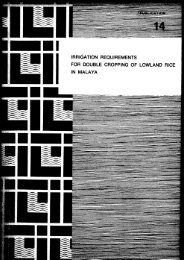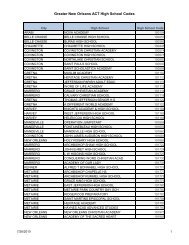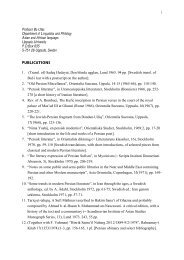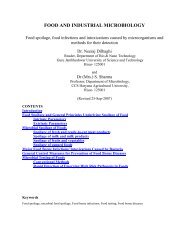On the Future of Indigenous Traditions - Munin
On the Future of Indigenous Traditions - Munin
On the Future of Indigenous Traditions - Munin
Create successful ePaper yourself
Turn your PDF publications into a flip-book with our unique Google optimized e-Paper software.
independent national’s developments have brought in a new change in presenting <strong>the</strong><br />
Adivasis and <strong>the</strong>ir reality. This new perception <strong>of</strong> <strong>the</strong>mselves (Adivasis) in <strong>the</strong><br />
administration in <strong>the</strong> hands <strong>of</strong> Indian elite brings in a newer change for <strong>the</strong> Adivasis.<br />
3.3. The state’s political notion and Adivasi<br />
developments after India’s independence<br />
The independent India, now free from <strong>the</strong> colonial rule, was to be governed by <strong>the</strong><br />
new Constitution, led by <strong>the</strong> elected representative from <strong>the</strong> country who had to<br />
choose a model <strong>of</strong> development for this new nation. The question for <strong>the</strong> National<br />
Planning Committee (NPC) set up by <strong>the</strong> Congress Party <strong>the</strong>n was that, from among<br />
<strong>the</strong> two perspectives and approaches <strong>of</strong> development models, which one would<br />
formulate a plan for India’s development, mainly <strong>the</strong> industrialization aiming for <strong>the</strong><br />
nation’s ‘economic regeneration’. Gandhi’s plan had a strong emphasis on smallscale,<br />
cottage industries to be <strong>the</strong> primary units <strong>of</strong> larger industry but was received<br />
with suspicion and criticism in NPC. Nehru, <strong>the</strong> NPC’s chairman, and <strong>the</strong> Prime<br />
Minister <strong>of</strong> <strong>the</strong> independent India had long believed that <strong>the</strong> large-scale<br />
industrialization alone could solve India’s problems <strong>of</strong> poverty and unemployment.<br />
Apart from Nehru’s own beliefs, <strong>the</strong> NPC’s reports on different spheres <strong>of</strong><br />
development reflected <strong>the</strong> vision <strong>of</strong> a powerful and growing class <strong>of</strong> industrialists,<br />
<strong>the</strong>ir supporters in politics and intellectuals with high qualifications in different areas,<br />
including science and technology 94 .<br />
The national policies regarding Adivasi or ‘tribal developments’ that came in <strong>the</strong> fifth<br />
decade after <strong>the</strong> independence started with that <strong>of</strong> Bhoodan (donate land) Movement<br />
in 1951, followed by Community Development Programme in 1952, village housing<br />
scheme in 1957, etc. These were followed by Agricultural District Programmes in <strong>the</strong><br />
following decade in 1960 and <strong>the</strong> Tribal Areas Development Programme in 1962. By<br />
<strong>the</strong> year 2000 one could see that <strong>the</strong>re were over 35 different programs implemented<br />
in <strong>the</strong> ‘Scheduled Areas’ and ‘Tribal Areas’. 95 However, <strong>the</strong> approach in <strong>the</strong><br />
implementation <strong>of</strong> <strong>the</strong>se programs for <strong>the</strong> Adivasis in <strong>the</strong>se areas was supposed to be<br />
94<br />
Krishna Kumar, “Mohandas Karamchand Gandhi (1869-1948)” Prospects, Vol. 23, 3/4, (1993),<br />
507–517.<br />
95<br />
V.S. Upadhyay and Gaya Pandey, Tribal Development in India (A Critical Appraisal) op. cit., 193.<br />
64

















